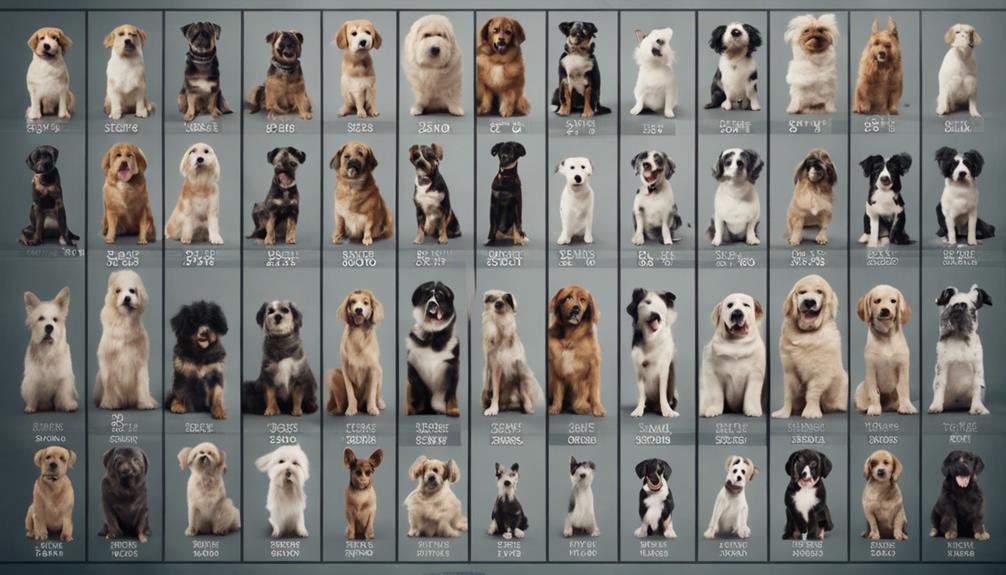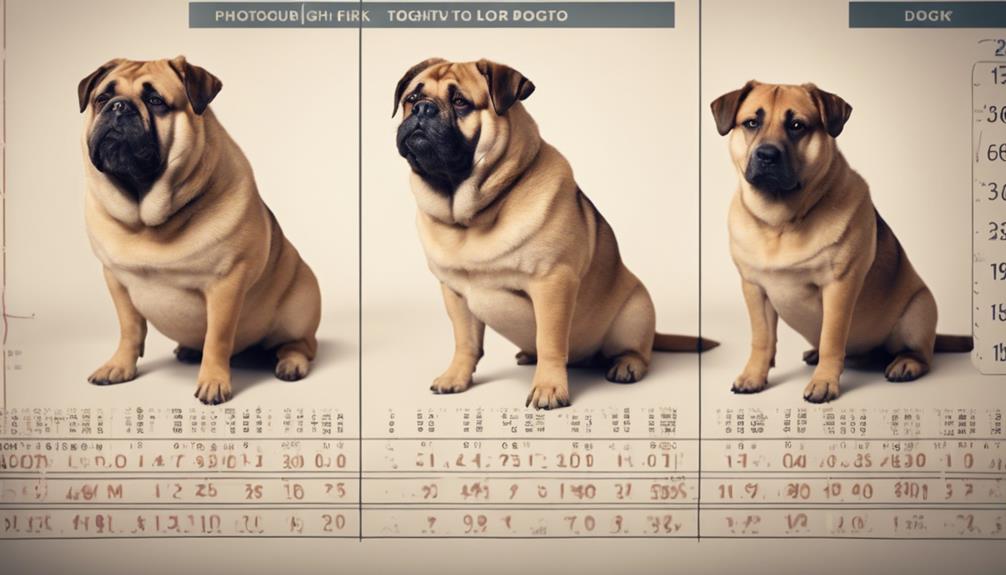Understanding your dog's healthy weight and body condition is crucial for their overall well-being. A dog weight chart serves as a valuable tool in assessing whether your furry friend is within the optimal weight range.
By utilizing this chart, pet owners can monitor their dog's weight status and make informed decisions regarding their diet and exercise regimen. The insights provided by the weight chart can offer valuable guidance on maintaining your dog's health and vitality.
Key Takeaways
- Assess your dog's weight category based on visible signs and body condition.
- Manage underweight dogs by increasing calorie intake and adjusting meals.
- Manage overweight dogs by increasing exercise, reducing treats, and calorie restriction.
- Consult with a vet to determine ideal weight, caloric needs, and monitor progress closely.
Understanding Dog Weight Categories
Understanding the various dog weight categories is essential for assessing and maintaining your canine companion's health and well-being. By recognizing where your dog falls within the weight spectrum, you can take appropriate steps to address any concerns.
Dogs can be categorized as severely underweight, underweight, ideal weight, overweight, or severely overweight. A severely underweight dog may appear bony, with visible ribs and loss of muscle mass. An underweight dog will have easily felt ribs and a visible waist.
Dogs at their ideal weight will have ribs easily felt without excess fat and a visible waist behind the ribs. Overweight dogs will have difficulty feeling ribs due to fat deposits, while those severely overweight will exhibit massive fat deposits over various body areas.
Monitoring your dog's weight category is crucial for their overall health.
Identifying Underweight in Dogs
Recognizing signs of underweight in dogs is crucial for ensuring their optimal health and well-being. Some indicators of underweight dogs include a visible ribcage, pelvic bones, and lumbar vertebrae, along with a loss of muscle mass. Additionally, an underweight dog may have a waist that is easily visible from above and a tucked-up abdomen from the side.
It is important to be able to feel the ribs easily without excess fat and to have a visible waist behind the ribs for a dog to be considered at an ideal weight. Monitoring your dog's weight and body condition regularly can help in identifying any deviations from their healthy weight range and taking appropriate actions to address any issues promptly.
Recognizing Ideal Dog Weight

Ensuring your dog maintains an ideal weight is essential for their overall health and longevity. Ideal weight in dogs is characterized by ribs that can be easily felt without excess fat, a visible waist behind the ribs, and a tucked-up abdomen from the side. Dogs at their ideal weight have a balanced body condition, allowing them to move comfortably and reducing the risk of obesity-related health issues.
Monitoring your dog's weight regularly and adjusting their diet and exercise as needed can help them stay within the ideal weight range. Consulting with a veterinarian for guidance on proper nutrition and weight management strategies is crucial in achieving and maintaining your dog's ideal weight for a healthy and happy life.
Signs of Overweight Dogs
Maintaining a dog's healthy weight is crucial for their overall well-being, and being able to recognize the signs of overweight dogs is essential in ensuring their long-term health.
- Excessive fat covering the ribs
- Difficulty feeling the ribs due to fat deposits
- Lack of a visible waistline
- Fat accumulation over the base of the tail and lower back
- Noticeable weight gain over a short period
Indicators of Severely Overweight Dogs

In cases of severely overweight dogs, excessive fat deposits are visibly prominent across various key areas of the body, indicating a critical need for weight management intervention. Dogs classified as severely overweight exhibit massive fat accumulations over the thorax, spine, and tail base. These dogs often lack a discernible waist and abdominal tuck, with visible or palpable fat deposits on the neck and legs.
Additionally, a distended abdomen is commonly observed in severely overweight dogs. Identifying these indicators of severe obesity is crucial in addressing the health risks associated with excess weight. Weight management strategies, including controlled feeding, increased exercise, and veterinary guidance, are essential in helping severely overweight dogs achieve a healthier body condition.
Managing Underweight Dogs
To address the condition of underweight dogs effectively, it is crucial to implement strategic dietary adjustments and monitor their progress closely.
- Conduct a thorough evaluation to identify potential reasons for underweight
- Increase the calorie intake gradually to support weight gain
- Adjust meal portions and frequency to meet the dog's nutritional needs
- Consider transitioning to higher-calorie dog food options recommended by a veterinarian
- Monitor the dog's weight and body condition regularly to assess the effectiveness of the dietary changes
Tips for Overweight Dogs

Addressing the issue of overweight dogs requires strategic dietary modifications and a dedicated approach to promoting weight loss effectively. Here are some tips for managing overweight dogs:
| Tips for Overweight Dogs | |
|---|---|
| Gradually increase exercise | Reduce treats and human food |
| Estimate necessary calorie restriction | Implement vet-approved weight loss tips |
Strategies for Healthy Weight Management
Implementing effective strategies for maintaining a healthy weight in dogs is crucial for their overall well-being and longevity. To achieve this goal, consider the following strategies:
- Regular exercise tailored to your dog's needs
- Providing a balanced and nutritious diet
- Avoiding excessive treats and table scraps
- Monitoring food intake and adjusting portions as needed
- Seeking guidance from a veterinarian for a personalized weight management plan
Steps to Achieve Ideal Dog Weight

In the pursuit of achieving the ideal weight for your dog, a crucial starting point is consulting with a veterinarian to establish tailored caloric requirements. By determining the specific caloric needs based on your dog's weight, age, activity level, and breed, you can create a personalized feeding plan to reach the desired weight.
Following the recommended daily calorie intake is essential to ensure gradual and healthy weight loss or gain. Additionally, utilizing hospital weight management programs can provide structured support and monitoring.
Seeking individualized advice for your dog's unique requirements and progress will help you stay on track and make necessary adjustments along the way. By following these steps diligently, you can effectively achieve and maintain your dog's ideal weight and overall health.
Exploring Related Articles
Upon delving into the realm of related articles, one can uncover valuable insights into topics such as canine weight management, dietary considerations, and health risks associated with overweight pets.
- How to Help a Dog Lose Weight
- How Much Should I Feed My Dog?
- Is My Cat Too Fat? What Should They Weigh?
- Obesity in Dogs: Risks and Solutions
- How Many Calories Should My Dog Eat?
Conclusion
In conclusion, maintaining a healthy weight for your dog is crucial for their overall well-being. By understanding the different weight categories and utilizing strategies for weight management, you can ensure that your furry companion stays healthy and happy.
Regular monitoring, proper diet, and exercise are key components in achieving and maintaining your dog's ideal weight. Remember to consult with your veterinarian for personalized guidance on your dog's weight journey.




